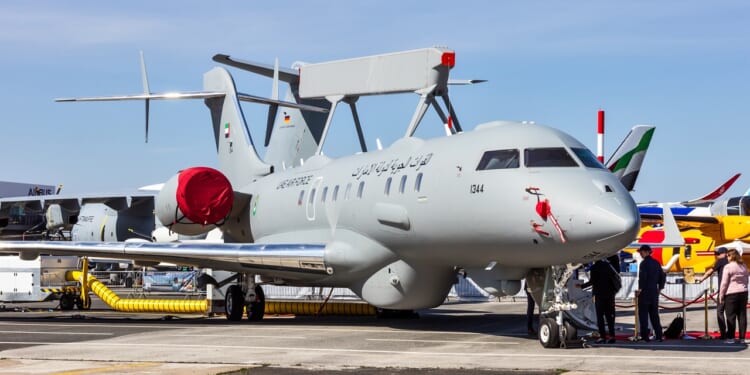Germany’s acquisition of Saab’s GlobalEye would be an important step on the long—and expensive—path to rearmament.
The security situation in Europe is drastically deteriorating as the Russians press forward with their war in Ukraine—and the Americans appear at the end of their rope, in terms of what assistance and time they can keep providing both to Ukraine and to Europe more broadly. Thus, the rest of Europe is having to step up or be left behind.
Germany, one of the most important countries in Europe, has been especially hit by the Ukraine War. Its post-Cold War economic miracle was built on cheap Russian energy. Now that is gone, damaging their economy at the same time Berlin is pursuing a rearmament. One of the ways that Germany is adapting to the new strategic environment in Europe is by purchasing greater early warning and command and control aircraft. As part of this movement, Berlin is interested in acquiring Saab’s GlobalEye airborne early warning and control (AEW&C) aircraft to replace its aging fleet and enhance its national surveillance capabilities.
Europe’s NATO Members Are Seeking Self-Reliance
This follows NATO’s decision to move away from the E-3A Sentry to the Boeing E-7 Wedgetail by 2031, leaving a real gap in Germany’s sovereign AEW&C operations. Defense Minister Boris Pistorius has stated that GlobalEye is best suited for this stopgap measure, with plans potentially involving up to six aircraft procured through NATO’s procurement agency for entry into service around 2031.
While not yet finalized, this move is part of broader efforts to modernize Germany’s air defense amid increasing regional tensions, including recent Russian airspace incursions. The GlobalEye, based on the Bombardier Global 6000/6500 business jet platform, would provide multi-domain surveillance over air, sea, and land.
The potential purchase represents a major upgrade for Germany’s defense posture, addressing the obsolescence of its current E-3A fleet and ensuring independent AEW&C capabilities rather than full reliance on NATO allies. It enhances early warning against threats like missiles, aircraft, and maritime intrusions, which is crucial given Russia’s aggressive actions in Europe—and the ongoing, escalating violations of NATO airspace likely by Russian aircraft and drones.
About the GlobalEye Airborne Early Warning & Control Plane
- Year Introduced: 2020
- Number Built: 5 (so far)
- Length: 99 ft 5 in (30.3 m)
- Wingspan: 94 ft 2 in (28.7 m)
- Weight : 99,500 lb (45,130 kg) MTOW
- Engines: Two Rolls-Royce BR710 A2-20 turbofan engines, each producing 14,750 lbs of thrust
- Maximum speed: 581 mph (935 km/h)
- Range: 6,835 mi (11,000 km)
- Service Ceiling: 51,000 ft (15,540 m)
- Loadout: No weapons; advanced avionics / comms; self-protection suite (see below)
- Aircrew: 2 pilots, 8-10 mission operators (total capacity for 17 personnel)
The GlobalEye’s Strategic Implications
Strategically, the acquisition of the GlobalEye bolsters Germany’s role within NATO, potentially allowing for shared operations with partners, like France, which has also expressed interest Saab’s AEW&C plane. Economically, it supports European defense industry growth, with Saab benefiting from increased orders amid a surge in continental military spending post-Ukraine invasion.
Should Germany get this plane, it would further align with Europe’s general push to be less reliant on an American ally that they view as increasingly ambivalent about the security situation in Europe.
Russian officials have not specifically commented on Germany’s intentions to purchase this AEW&C plane. More generally, Moscow has complained about NATO’s military expansions, including the acquisition of new surveillance capabilities—which Russian leaders view as fanning the flames in an already tense situation. For his part, Russian President Vladimir Putin has threatened Germany with a swift military response if it were to participate more directly in the Ukraine War. Relatedly, Russia views joint German-Swiss procurements of air defense systems, like IRIS-T, as escalatory, and Kremlin officials have suggested that they will develop and deploy their own countermeasures against these new European systems.
Germany May Need the GlobalEye Sooner Rather than Later
The Saab GlobalEye comes equipped with advanced sensors for air, maritime, and ground surveillance. It features Erieye ER S-band AESA radar for long-range detection, gallium nitride technology for enhanced performance, and integrated systems for electronic warfare, signals intelligence (SIGINT), and it excels at extended missions by providing real-time intelligence across domains.
Along with the above capabilities Saab’s GlobalEye comes with a maritime surveillance radar, electro-optical/infrared sensors, satellite communications (SATCOM), voice/data links, synthetic aperture radar (SAR), ground moving target indication (GMTI), and full self-protection suite (jammers, chaff/flares).
In all, Germany’s acquisition of Saab’s GlobalEye would be an important step on the long—and expensive—path to rearmament. Given that the current geopolitical moment on the continent is only going to worsen, Berlin will likely end up with the planes sooner rather than later.
About the Author: Brandon J. Weichert
Brandon J. Weichert is a senior national security editor at The National Interest. Recently, Weichert became the host of The National Security Hour on America Outloud News and iHeartRadio, where he discusses national security policy every Wednesday at 8pm Eastern. He is also a contributor at Popular Mechanics and has consulted regularly with various government institutions and private organizations on geopolitical issues. Weichert’s writings have appeared in multiple publications, including The Washington Times, National Review, The American Spectator, MSN, The Asia Times, and others. His books include Winning Space: How America Remains a Superpower, Biohacked: China’s Race to Control Life, and The Shadow War: Iran’s Quest for Supremacy. His newest book, A Disaster of Our Own Making: How the West Lost Ukraine is available for purchase wherever books are sold. He can be followed via Twitter @WeTheBrandon.
Image: Shutterstock / VanderWolf Images.


















